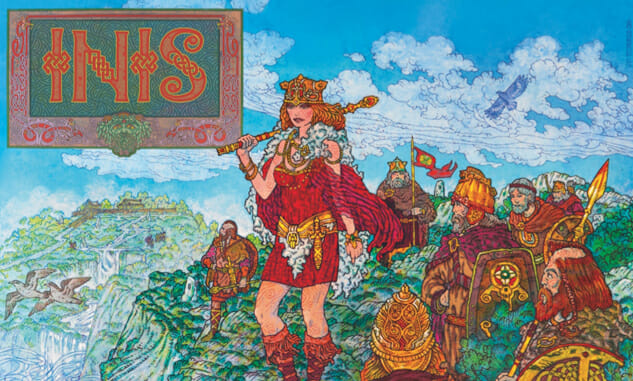
Inis brings a Celtic theme (as if that weren’t incredibly obvious from the ornate and somewhat intimidating cover art), to what is at its heart a very simple game of area control on a small board that grows incrementally over the course of play. The rules are very straightforward. Players compete to gain one or more of the three victory conditions required to end the game, but it’s all about the cones… I mean, the cards, which are the only way you can move your pieces and gain control of other areas.
Each player has 12 tokens, called “clans,” that will move on to and around the board as the game progresses. Clans from different players can be on the same area at the same time without automatically causing a battle; the player with the most clans on that area is the “chieftain,” and gains a special card associated with that area, but that can change from turn to turn. Some areas have citadels, each of which can hide one clan in case of war, or sanctuaries, which are important in the final scoring.
Each player can pursue a different strategy without necessarily instigating conflicts all over the board. A win can be achieved by satisfying one of these three victory conditions: become chieftain over at least six clans from opposing players, establish clans in at least six areas of the board, or have clans present in areas with at least six sanctuaries present (there can be multiple sanctuaries in an area). Achieving any of these is difficult, as you might expect if you’ve played other area-control games that take place on a small board, but Inis gives you wildcards, tokens you can acquire via cards over the course of gameplay, called Deeds, to reduce the thresholds for victory.
On each turn, players start with hands of four cards, choose one, and pass the remainder to the left in a card-drafting system not unlike that pioneered by 7 Wonders. The same cards appear in every round – there are 17 total, four of which are only used in four-player games, and in each round one card is randomly removed from the deck. Their functions are basic: move a clan or two, place a clan or two, add an area, draw a card from the Epic Tale deck, place a citadel, and so on. There’s also one card, called the Geis, that allows a player to immediately cancel the effect of a card another player just played – potentially wiping out an attack from a Conquest card, for example.
On a turn, a player may either play one card from their hand, pass for that turn (although they may play a card later in the round), or declare that they have achieved at least one victory condition and claim a Pretender token, which is necessary to win the game after the round has ended. There’s some merit to strategic passing, trying to tease out certain cards from other players’ hands, although in practice we found it was rare.
The heart of Inis is conflict, but it’s not about all-out war; being the chieftain brings benefits, but being alone in control of a territory isn’t useful for winning the game, because you’re chieftain over zero clans in that case. Thus, if you’re going to start a fight, you’re hoping to gain the upper hand and then agree with your opponent(s) to end that specific conflict in that area. Battles are painful: each player, in turn, must either discard a card from their hand or remove a clan member from that area, with the defending player going first and thus at a disadvantage even if the two sides have the same size armies in the battle. So to win, you’ll need to fight, but only a little bit, and hopefully the war ends early with everyone still on the table.
The game’s suggested playing time is an hour, but if the players are evenly matched you can extend the game beyond that. Gains near the end are incremental; it’s easy to get close to a victory condition, but hard to get all the way to six in any of the three categories, so you’ll end up playing it out until someone gains enough Deed tokens to make up the gap or gets lucky enough in the card draw to gain the upper hand. That also means it’s very hard for someone to get completely blown out in Inis – the worst that will happen in a 3- or 4-player game is you’ll be competitive but without a path to victory as the other players duke it out.
Inis plays two to four, using hands of six cards instead of four for two-player games, and my ten-year-old daughter had no problem understanding the rules or mechanics. There’s a lot of strategic depth here, but Inis gets by with fairly few rules and only a handful of unique terms, so the barrier to entry for new players is low – as long as you can get past the garish cover art – and plenty to keep the more hardcore gamers happy for multiple plays.
Keith Law is a senior baseball writer for ESPN.com and an analyst on ESPN’s Baseball Tonight. You can read his baseball content at search.espn.go.com/keith-law and his personal blog the dish, covering games, literature, and more, at meadowparty.com/blog.


